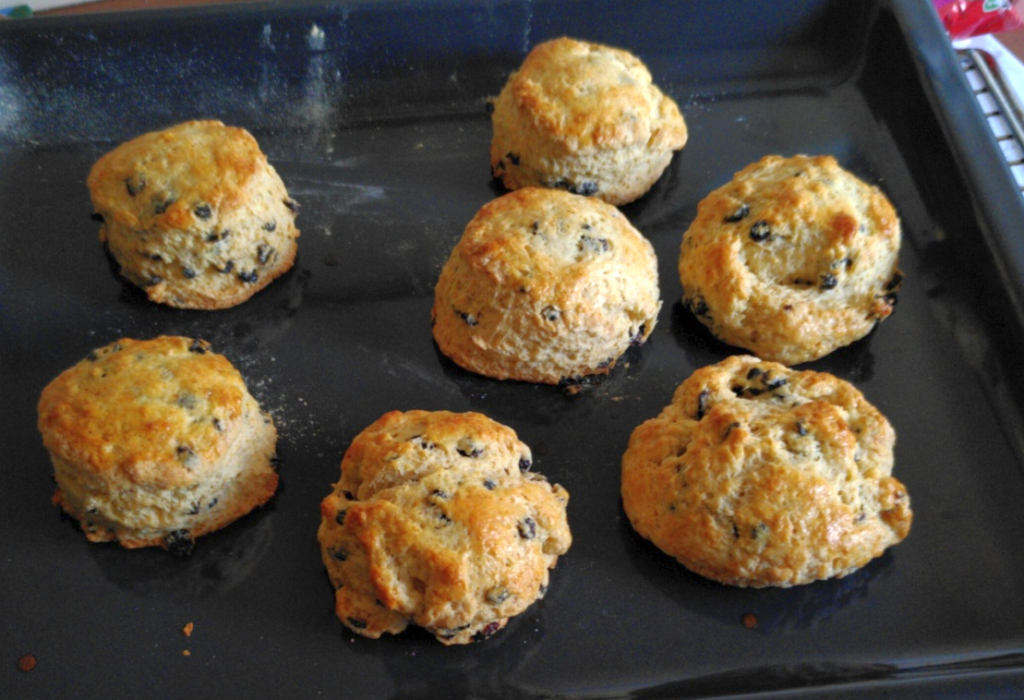Search the Blog
Latest Comments
Scones.
There's a few places, though, where I find them acceptable - or even necessary. One prime example?
Scones.

I love scones. Preferably with clotted cream (which is hard to get in Germany). So here's my recipe for scones, just in case you are feeling like going on a bit of a pandemic baking spree, like so many others:
75 g raisins or currants (I prefer currants)
115 g buttermilk
75 g butter
45-50 g sugar
1 large egg
pinch of salt
15 g baking powder (amount generally recommended for 500 g of flour)
340 g flour (typically wheat, I use spelt)
optional: quarter teaspoon of baking soda (or less)
Soak raisins or currants in buttermilk for at least one hour.
Mix cold butter, flour, salt, baking soda and baking powder to prepare for making a shortcrust-type dough. Form into a ring on your work surface, add buttermilk, currants, and egg to the inside of the ring; knead until it forms a smooth dough.
Roll out your dough straight away (no rest needed), to about 2.5 cm of thickness on a floured surface, then use a glass or a suitably sized round cookie cutter to cut circles. Put on baking sheet and wash with leftover buttermilk or an egg-buttermilk-mix or just egg. (I tip the buttermilk and currants into the floury ring, then whisk the egg in the now-vacated bowl, then tip it into the ring as well. The bits of egg and buttermilk left in that bowl are enough or almost enough to glaze the scones; they definitely are if another small bit of buttermilk is added.)
Bake at 189-190°C in a non-fan oven, for about 15 minutes.
They still taste nice the day after baking, and even the day after that. They never survived for longer in our household...
Comments 5
Our lowish sugar, low resource and dodgy oven recipe is adapted from the BBC website: 225g (8 oz) self raising flour, 55g (2 oz) butter, 150ml milk, pinch of salt, make flour and butter into bread crumbs in a bowl, add milk to make into dough, stick in oven at default 200oC setting until it starts to go golden.
Round here we can get clotted cream, but different types of milk is trickier. This version won't be absolutely scone like, but given how fast they disappear it can't be bad.
We've been adapting BBC and National Trust recipes to low/no sugar versions, which has been wonderfully instructive in how much sugar goes in to each one and what it does to the structure.
I'm sure it'll benefit from adding some fruit.
Yes, sugar is definitely not only for the sweetness, but also has a huge impact texture-wise. My suspicion is that some of my buttercream problems come from reduced sugar... still haven't gotten around to doing a proper experiment on this, though!
No sugar for me is kind of meh for a lot of things that are supposed to be sweet, though (and I'm not fond of sugar replacements, which might alleviate this). There's a point where I feel that more sugar won't really affect the taste, only maybe the texture, so some of it can be cut from the recipe. But there's also a point under which the baked thing suddenly becomes boring and lackluster and not very delightful anymore. Somewhere inbetween, for me, there's the sweet spot. Literally



